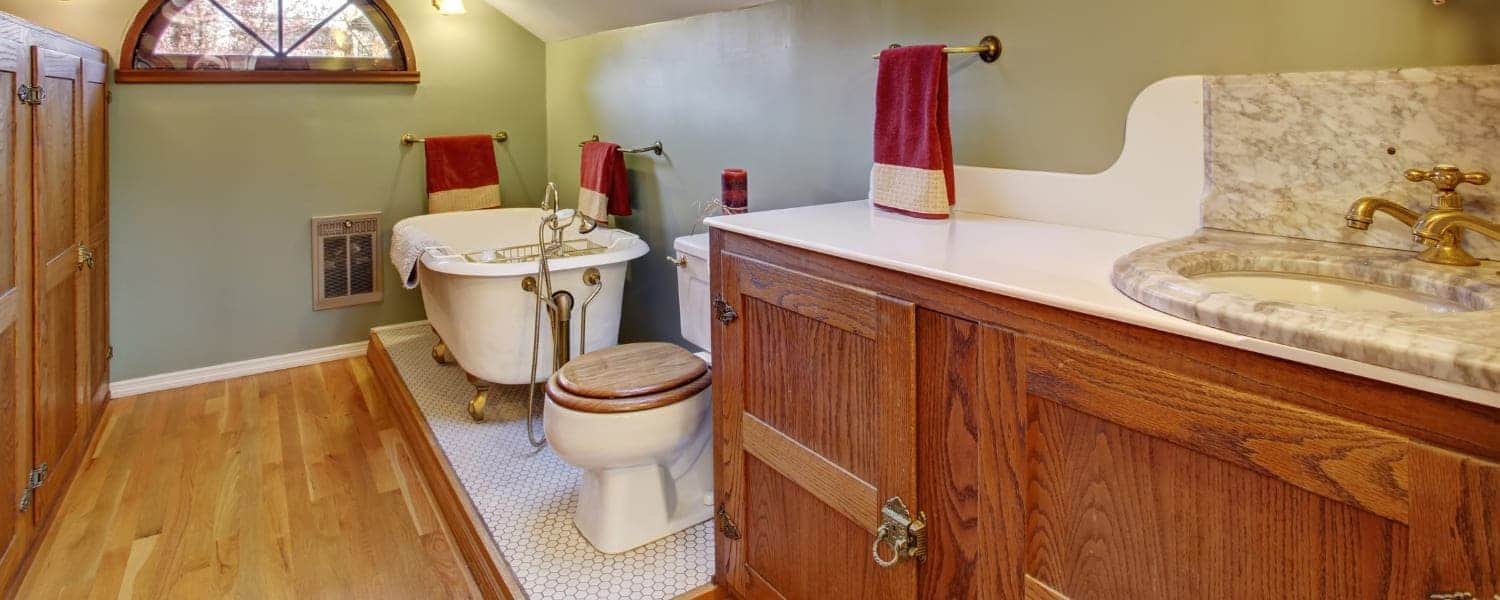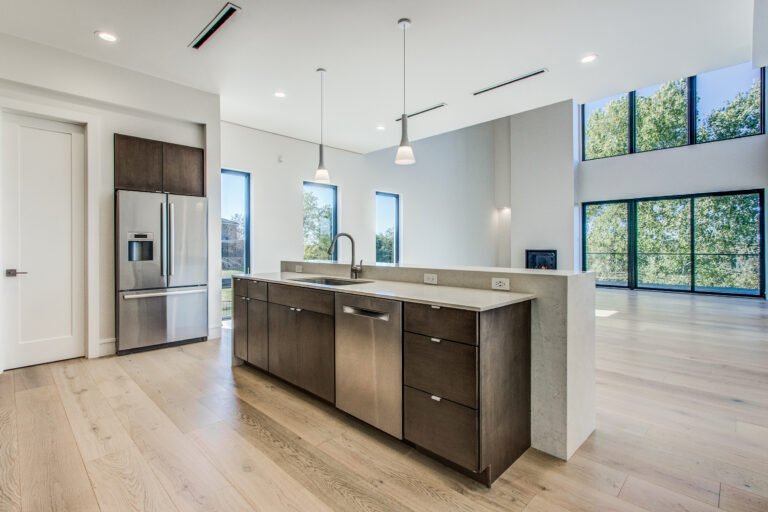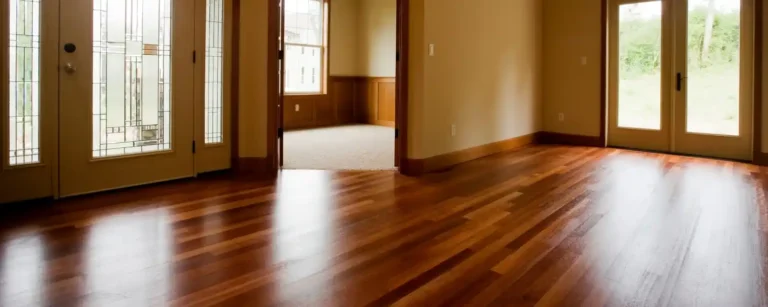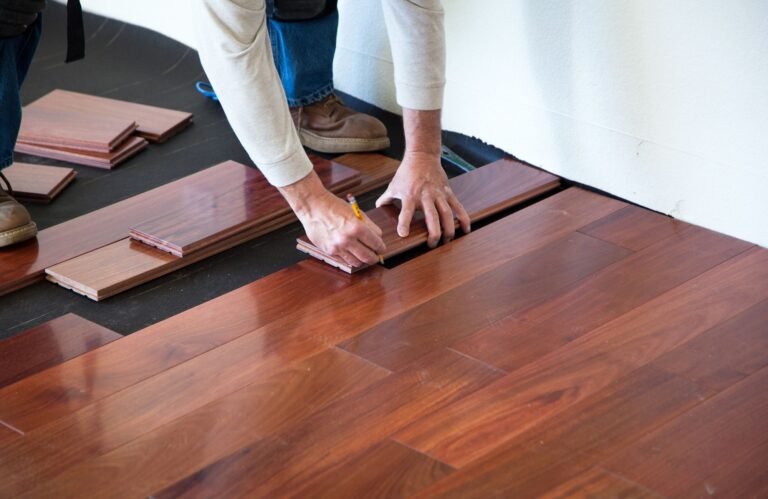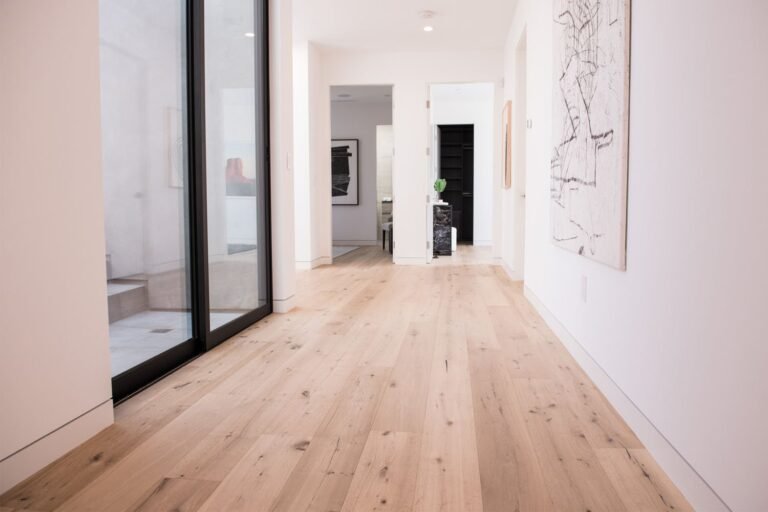Can You Put Engineered Hardwood in a Bathroom? Your Complete Guide
Is it a good idea for a home contractor or DIY-er to install engineered hardwood in a residential bathroom? You might wonder if it’s a good choice for the household rooms that encounter the most moisture, from steam to sink and tub splashes to floor puddles left by soaking wet children and pets. This article will examine whether engineered hardwood works well in bathrooms and how it handles moisture compared to other modern wood flooring options. We’ll also discuss the style and functionality it brings, helping you decide if it makes your bathroom both elegant and practical. Get ready to discover everything manufacturers, architects, interior designers and other home improvement professionals know about using engineered hardwood in your bathroom, including its advantages and potential drawbacks. Will it suit your home? Let’s explore the possibilities and find out together!
Understanding Engineered Hardwood Flooring
What is Engineered Hardwood Flooring?
Engineered hardwood flooring is a strong and versatile alternative to traditional hardwood. It’s made by bonding layers of real wood veneer together with adhesives. This construction gives the flooring strength and stability while preserving its natural beauty.
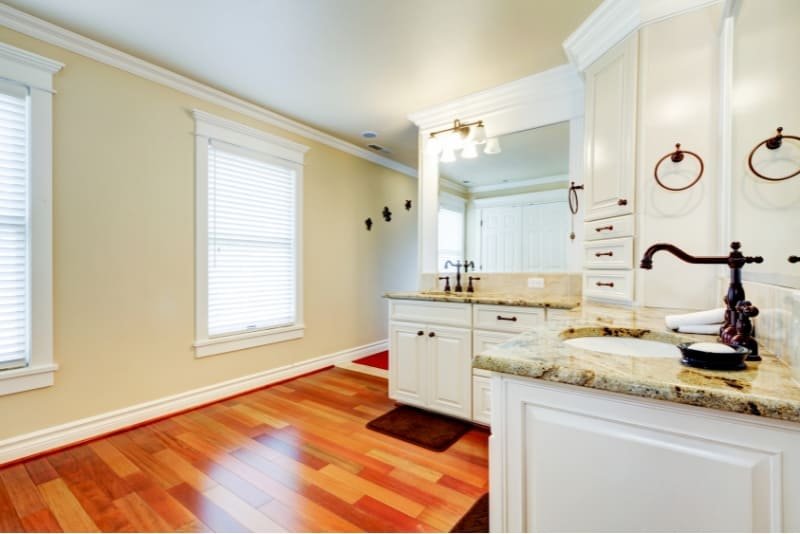
Benefits of Engineered Hardwood Floors
Engineered hardwood floors have many benefits. Let’s understand them in detail:
- Durability: Engineered hardwood can withstand changes in moisture and temperature, making it less prone to warping or cupping.
- Versatility: We can install engineered hardwood in various environments, including kitchens, basements and… yes, even bathrooms!
- Easy Installation: We can install engineered hardwood using different methods, making it suitable for all subfloors.
- Aesthetic Appeal: It is available for many finishes and wood species, allowing homeowners to choose their preferred finish.
Composition of Engineered Hardwood Flooring
Engineered hardwood typically consists of three to five layers:
- Top Layer: This is the wear layer, comprising real hardwood veneer. It provides the visual appeal and scratch-resistant durability that are characteristic of hardwood floors.
- Core Layers: The core layer is made of HDF or plywood and provides stability and structural integrity to the flooring.
- Bottom Layer: The backing layer serves as a stabilizing base for the flooring, enhancing its resistance to moisture.
To learn more about Engineered Hardwood Flooring, read our comprehensive blog, “What is Engineered Hardwood Flooring?“
Why Engineered Wood Flooring is Suitable for Bathrooms
Despite the commonly held misconception that hardwood flooring is unsuitable for bathrooms due to moisture exposure, engineered hardwood can be a practical choice for these spaces. Here’s why:
- Moisture Resistance: Engineered hardwood’s layered construction protects it from moisture damage. The core layers stabilize the wood flooring planks, preventing excessive expansion or contraction in humid environments.
- Easy Maintenance: Cleaning and maintaining finished or even prefinished (natural) engineered hardwood flooring is a breeze, requiring only sweeping and occasional mopping.
- Warmth and Comfort: Unlike cold and hard tile floors, engineered hardwood adds warmth and a comfortable surface to walk on, enhancing the bathroom’s ambiance.
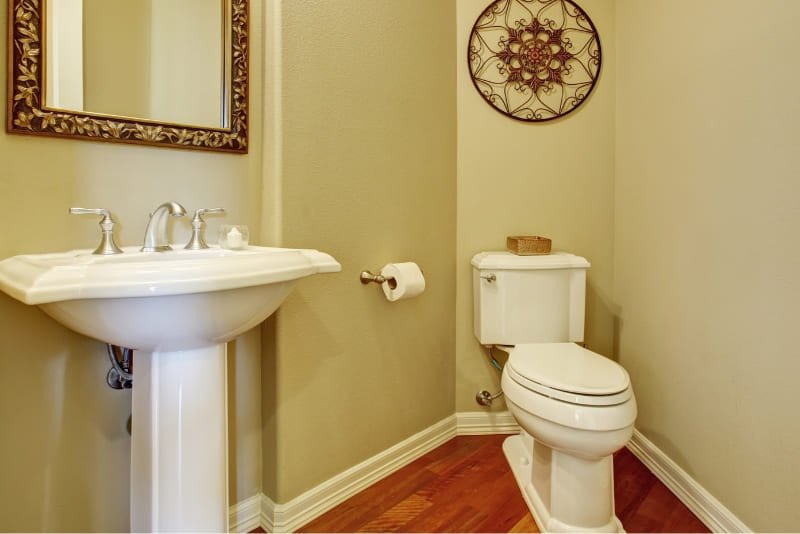
Pros and Cons of Engineered Hardwood in Bathrooms
Before deciding on engineered hardwood flooring for your bathroom, it’s important to consider the advantages and drawbacks in order to make an educated and sensible interior design decision.
Pros:
- Elegant Appearance: Engineered hardwood adds a traditional yet highly sophisticated charm to bathrooms, enhancing their beauty with natural wood.
- Moisture Resistance: With proper sealing, engineered hardwood can handle bathroom moisture quite capably, reducing the possibility of warping, mold growth and other negative effects.
- Durability: Engineered hardwood’s strong construction ensures it can withstand the rigorous daily demands of bathroom usage by residents and guests, guaranteeing long-lasting performance.
- Low Maintenance: Maintaining engineered hardwood in bathrooms is minimal, making cleaning routines hassle-free.
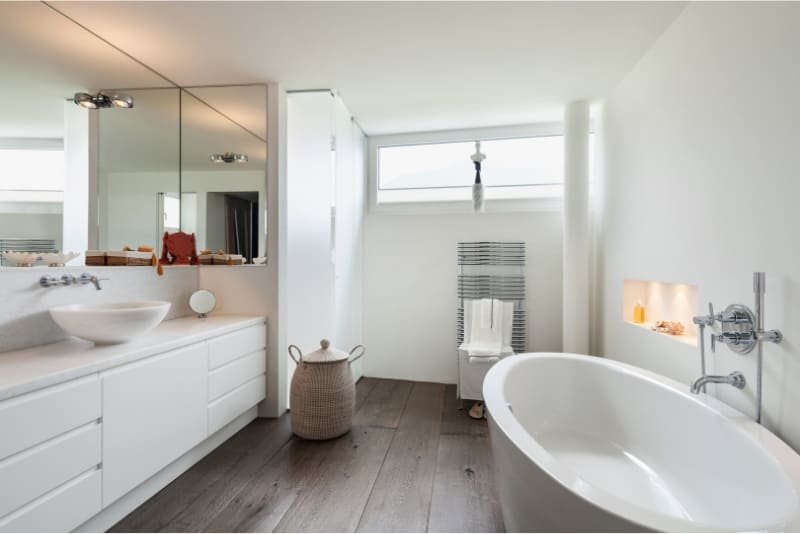
Cons:
- Water Vulnerability: Extended water exposure or high humidity may gradually harm engineered hardwood.
- Higher Cost: Engineered hardwood tends to be more expensive than other flooring options.
- Installation Complexity: Installing engineered hardwood in bathrooms is more complex. It involves meticulous preparation of the subfloor, including proper sealing.
- Limited Refinishing: The thin top layer of engineered hardwood restricts refinishing possibilities, affecting long-term maintenance needs.
Installation Tips for Engineered Hardwood in Bathrooms
Preinstallation Considerations
Before installing engineered hardwood flooring in bathrooms, it’s important to address the following considerations:
- Subfloor Assessment: Ensure the bathroom subfloor is clean, level and moisture-free. Fix any issues like unevenness or water damage before proceeding with installation. A consultation with a residential building contractor or a flooring specialist retailer is highly advised.
- Acclimatization: Allow the engineered hardwood planks to adjust to the bathroom environment for at least 48 hours before installation. It helps reduce the risk of expansion or contraction post-installation.
- Moisture Testing: Test the moisture levels of the subfloor to ensure they meet the manufacturer’s specifications for installing engineered hardwood in humid areas. Use a moisture meter for accurate results.
Best Practices for Installation
Follow these best practices for a successful installation:
- Adhesive Selection: Choose a high-quality adhesive compatible with the flooring material for moisture-prone areas like bathrooms.
- Precision Cutting: Take accurate measurements and use precise cutting tools to achieve proper fits around fixtures, corners and edges. It minimizes gaps and enhances the flooring’s appearance.
- Expansion Gaps: Leave gaps around the bathroom’s perimeter to allow for potential changes in humidity levels.
Waterproofing and Protective Measures
To enhance durability and longevity, consider these waterproofing and protective measures:
- Edge Sealing: Apply a waterproof sealant to the edges and seams of the flooring. It creates a barrier that resists moisture.
- Waterproof Underlayment: Use waterproof underlayment beneath the flooring to provide additional protection against moisture from the subfloor.
- Routine Maintenance: Implement a regular maintenance schedule to keep the flooring clean and dry. Promptly clean up spills and avoid leaving standing water on the floor.
Maintenance and Care for Engineered Hardwood in Bathrooms
Maintaining and protecting your engineered hardwood flooring is crucial for its durability and appearance. Follow these tips to care for your investment:
Daily Maintenance Tips
- Regular Cleaning: Sweep or vacuum the floor regularly to remove dust, dirt and debris. Use a soft-bristle broom or a vacuum with a hardwood floor attachment to avoid scratches.
- Gentle Mopping: Use a mild hardwood floor cleaner and a damp, wrung-out cloth or mop to clean the floor. Avoid excessive water, as it can cause damage by seeping into seams.
- Prompt Spill Cleanup: Immediately wipe up any spills or splashes to prevent water from penetrating the flooring. Absorb the liquid with a dry or paper towel, then use a damp cloth for thorough cleaning.
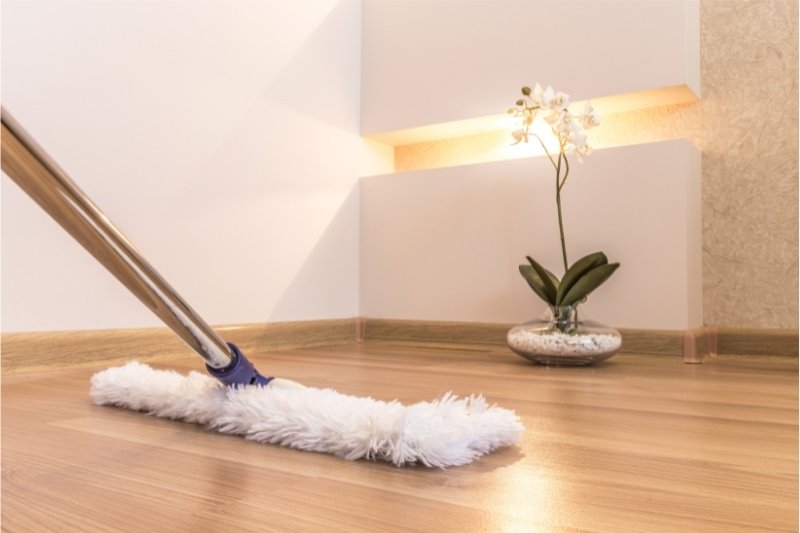
Preventing Water Damage
- Use Mats and Rugs: Place mats or rugs in high-traffic areas, near sinks and outside the shower to trap water and protect the flooring. Ensure the mats have a non-slip backing to prevent accidents.
- Sealant Maintenance: Regularly inspect and maintain the sealant. Apply a new coat of sealant as necessary to provide optimal protection against water damage.
- Avoid Standing Water: Quickly wipe up any standing water on the floor, especially around sinks, toilets and showers. Standing water can seep into seams and joints, leading to swelling, warping and mold growth.
Importance of Proper Ventilation
- Ventilation Systems: Ensure proper ventilation to reduce humidity and prevent moisture buildup. Use exhaust fans during and after showers to expel the moist air outside.
- Natural Ventilation: Open windows or doors to allow fresh air circulation and reduce moisture. It helps maintain optimal indoor humidity levels and prevents condensation on the flooring.
- Regular Inspection: Regularly check the bathroom for signs of water damage, such as discolored or warped flooring or musty odors. Address any issues promptly to prevent further damage and ensure the flooring’s longevity.
Alternatives to Engineered Hardwood for Bathrooms
While engineered hardwood is a suitable option for bathrooms, alternative options exist. Here are some alternatives:
- Porcelain or Ceramic Tile: These tiles are popular for bathroom flooring because they are durable, water resistant, and offer various design options. They are easy to clean and imitate the appearance of wood or other materials.
- Luxury Vinyl Planks: These planks closely resemble hardwood and are waterproof and low-maintenance. They are highly durable, resistant to water and scratches and come in various styles and colors. Learn the difference between Luxury Vinyl Planks and Engineered Hardwood in our other blog, “LVP Vs Engineered Hardwood Flooring“
- Natural Stone: Marble, granite or travertine can add a luxurious and timeless appeal to bathroom floors. While they may be more expensive and logistically more difficult to install, they are durable and moisture-resistant.
- Laminate Flooring: Laminate flooring is a cost-effective alternative to hardwood with excellent water resistance. It’s easy to install, requires low maintenance and comes in various styles and colors.
- Vinyl Sheet Flooring: Vinyl sheet flooring is another budget-friendly option with excellent water resistance and durability. It’s available in various designs, including wood and tile patterns.
Making the Decision: Is Engineered Hardwood Right for Your Bathroom?
Engineered hardwood is a great choice for bathroom flooring as it combines practicality and beauty. Its moisture resistance, durability and easy maintenance make it ideal for homeowners who want to add warmth and charm to their bathroom. By following proper installation and care steps, engineered hardwood can enhance the overall feel of any bathroom.
Villagio Wood Floors, a California-based wholesaler, offers high-quality engineered hardwood flooring that caters to the diverse needs of retailers and their customers. From classic rustic to postmodern chic and any specialty pattern you can dream up, you can achieve your desired look for any bathroom project with various finishes and wood types. Explore our Collection today and upgrade your bathroom!
Can You Put Engineered Hardwood in A Bathroom – FAQ Section
How does engineered hardwood compare to tiles in terms of comfort and warmth in a bathroom?
Engineered hardwood is warmer and more comfortable underfoot than tiles, which can feel cold and hard.
Can engineered hardwood be used in a full bath, or is it better for powder rooms?
We can use engineered hardwood in full baths and powder rooms. However, extra precautions are necessary. These precautions include sealing and ensuring proper ventilation.
How does humidity affect the lifespan of engineered hardwood in a bathroom?
Changes in humidity can cause engineered hardwood to expand and contract, potentially leading to gaps or structural damage. Allowing the wood to adjust to the room’s conditions before installation is important to prevent this. Maintaining stable indoor humidity levels is also important.
What warranty factors should be considered when selecting engineered hardwood for a bathroom?
When choosing engineered hardwood for your bathroom, it’s important to check the manufacturer’s and/or retailer’s product warranties. Ensure it covers moisture damage and humid environments. Additionally, ensure the warranty aligns with your bathroom’s specific needs.

